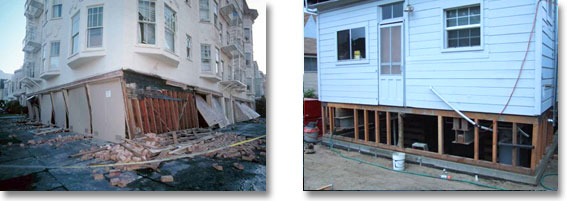
Protecting Your Largest Investment
Older buildings throughout California are vulnerable to extensive damage from seismic ground shaking. All jurisdictions allow voluntary structural strengthening (earthquake retrofitting), and some have mandatory programs. Buildings erected before 1981, when stricter structural design standards were adopted by the state, are more susceptible to earthquake damage. While some jurisdictions have adopted minimum design standards for earthquake retrofitting, building owners may generally choose any prescriptive (“cook book”) or performance (engineered) structural standard for retrofitting their buildings. The key to selecting the “right” standard is understanding the expected amount of damage your building will have after an earthquake:
- Collapse safeguard – costly repairs for re-occupancy or demolition
- Re-Use safeguard – less costly repairs for re-occupancy
- Re-Occupancy safeguard – cosmetic repairs for re-occupancy
Soft Story Buildings
In general, buildings must be able to adequately resist two forces-of-nature:
- Vertical Forces (gravity) – building’s self-weight and weight of its contents
- Horizontal Forces (lateral) – wind and earthquake.
Many older buildings have a built-in structural weakness called “Soft Story” which makes them particularly vulnerable to earthquake forces. A Soft Story has less than 80% of the horizontal strength of the story-above. Soft Stories are typically found in buildings which have large wall openings on the ground floor (e.g., store-front windows, garage doors) or have cripple walls sandwiched between the foundation and the building above (see photographs above).
Earthquake Soft Story explained by Bay Area Soft Story Retrofit Resources. Includes Videos and Photos
- What is a Soft Story
- San Francisco Mandatory Soft Story Retrofit Program
- Berkeley Soft Story Retrofit Program
- Soft Story Collapse Video
Measuring Earthquakes
There are three widely used methods to compare the amount of energy released by earthquakes:
- The Mercalli Intensity Scale (circa 1900) measures the observed effects of an earthquake (level I = unnoticeable, level XII = total destruction).
- The Richter Magnitude scale (circa 1935), measures the amplitude of an earthquake’s “S” waves (ground-shaking force) on a seismograph.
- The Moment Magnitude Scale (circa 1970) measures the amount of movement along an earthquake’s fault zone using ground seismometers and computers.
The Richter and Moment Magnitude Scales are logarithmic. A 7.0 earthquake releases about 31 times more energy than a 6.0 earthquake. The maximum magnitude of a earthquake is estimated to be 9.
Check the Links below for additional information about Earthquake Retrofitting.
Links
BUILDING in CALIFORNIA
- Forums
- Earthquake Retrofitting Blog
- Library
- National Public Radio – Engineers Put Wood House to the Quake Test
California Office of Emergency Services
California Earthquake Authority
California Seismic Safety Commission
California Building Code, Existing Building Code, and Historical Building Code
- Chapter 16 – Structural Design
- Chapter 16A – Structural Design
- Chapter 17 – Structural Tests & Special Inspections
- Chapter 17A – Structural Tests & Special Inspections
- Appendix L – Earthquake Recording Instrumentation
- Historical Bldg Code Chapter 8-7 – Structural Regulations
- Appendix Chapter A1 – Seismic Strengthening Provisions for Unreinforced Masonry Bearing Wall Buildings
- Chapter A3 – Prescriptive Provisions for Seismic Strengthening of Cripple Walls and Sill Plate Anchorage of Light, Wood-Frame Residential
Association of Bay Area Governments
Federal Emergency Management Agency
- Seismic Rehabilitation Process
- FEMA AP 807 document for Soft Story
- Performance-Based Seismic Design Procedures for New and Existing Buildings.
( From Applied Technology Council) Includes multiple FEMA documents and downloadable software and spreadsheet for building evaluation
Structural Engineers Association of Northern California
Hardy Frame
Simpson
Sponsors
